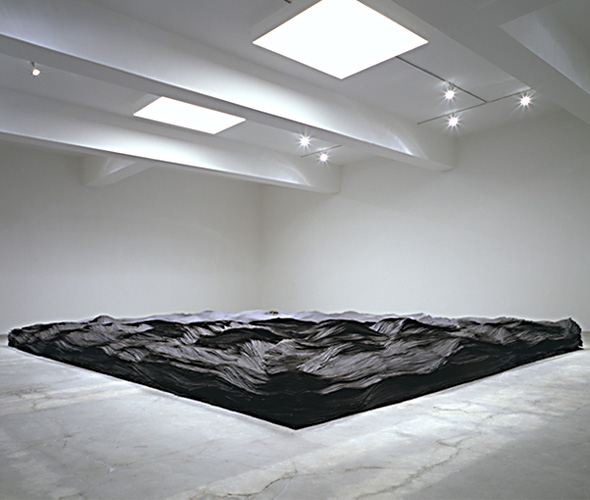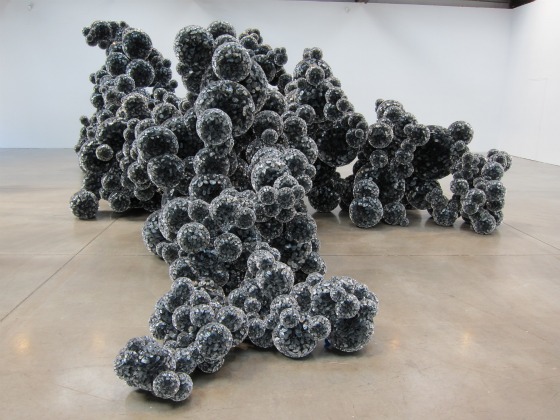Sculpture has been, along with painting, the standard of measurement for all great cultures. I think that sculpture up to the end of the 1950's really talked about the wealth and standing of the countries it came from. There is an internal decadence and seriousness of marble and bronze. They are expensive, labour intensive products that require years of building the skills necessary to make work let alone to complete. .
 Gian Lorenzo Bernini, Ludovica, marble, 1674
Gian Lorenzo Bernini, Ludovica, marble, 1674
Modernist sculpture has one of the hardest problems an artist can ever face. If you build it, they may not come. No big surprise there. But how about; If you build it, now what the hell do I do with it?
Of course, things start small. You don't just start building 40' by 100' pieces and expect a buyer to waltz in with an empty basket ball court and a briefcase full of cash. It starts small, depends on grant programs and curators to help it grow, and museum culture as well as a tiny elect group of uber rich collectors to find the space and storage once it's built.
 Richard Serra, Strike: To Roberta and Rudy, corden steel, 1969 - 1971
Richard Serra, Strike: To Roberta and Rudy, corden steel, 1969 - 1971
This has led to the exceptions in the field being at the extremes. It's led to both a spacial fragility and aggresive decadence of sculpture to the scale we have never seen before. Richard Serra (above) worked with the exremely durable product corden steel in making work for inside and out side the gallery. In the same year, Robert Irwin (below) was making sculpture with next to nothing and achieving similiar affects.
 Robert Irwin, Slanted Light Volume, scrim fabric and light, 1971
Robert Irwin, Slanted Light Volume, scrim fabric and light, 1971
These extremes and the inbetweens have led to a culture of creating that next to no concern with private buyers and intense concern with experience and working with new materials.
Selling work specifically to a museum is a different kind of deal; the ideal product for the museum is highly conceptual (art that is about something not necessarily obvious when first looking at it), with a flash bang that also attracts the crowds. But it's cultural worth, determined by curators and boards of museum directors, is of paramount value with the money and real estate these facilities hold making the practicality of owning these less a concern.
How this extremely specific audience had affected the work that is made in our time is tough to say but obvious in looking. Without the umbrella of institutional support, many weird and exceptional things may never have been made. The edges of what is possible and feasible are expanding making it an exciting time to look at what is coming next.
In the first of two articles I am focusing on sculpture as it goes forward in our time. To begin, we'll look at Tara Donovan.
----
Tara Donovan came out of art school and waited tables for a solid 6 years before she stumbled upon something. She had been steadily making work but barely showing it. One night when playing with toothpicks, a common work item she had been experimenting with, she dropped a box and when she picked it up she found the toothpicks bundled in a corner as the box slipped off.
"They held a perfect corner," she recalled. Over a month later, on a waitress salary, she had made this.
 Tara Donovan, Toothpicks, Toothpicks Held Together by Friction & Gravity Only, 2001
Tara Donovan, Toothpicks, Toothpicks Held Together by Friction & Gravity Only, 2001
 Tara Donovan, Toothpicks, Toothpicks Held Together by Friction & Gravity Only, 2001, (detail)
Tara Donovan, Toothpicks, Toothpicks Held Together by Friction & Gravity Only, 2001, (detail)
The first lesson came from this piece as it was not shown as the photo above portrays it. She showed this work in a large show with many other artists in the same room at the Maryland Art Fair. Her first review of the work referred to it as "a bale of hay." Deflated, she looked at her mistakes. Context was her final conclusion.
And the former conditions mentioned, the immaculately conceived gallery conditions that allow large objects to breathe, became her determined landing space. She understood that this work needed to be seen in a proper context and would work.
More shows, more disappointments, more school. But finally working out of a studio, she had the space and clarity to work out some of the kinks in ideas that space allowed and things started to come together. Her next large show was put together by loans from friends and a big enough space to realize her next piece.
 Tara Donovan, Transplanted, ripped and stacked tarpaper, 2003, IBM space variation
Tara Donovan, Transplanted, ripped and stacked tarpaper, 2003, IBM space variation
 Tara Donovan, Transplanted, Ripped and stacked tarpaper, 2001, Ace Gallery LA variation
Tara Donovan, Transplanted, Ripped and stacked tarpaper, 2001, Ace Gallery LA variation
From here, things progressed quickly. Being signed with Ace Gallery, entered into the Whitney Biennial in 2000, and a few years later after much haggling given their entire New York space to show in. After receiving the Macarthur Fellowship in 2008, her future as a literal "genius" was set.
 Tara Donovan, Untitled, Styrofoam Cups and Hot Glue, 2003
Tara Donovan, Untitled, Styrofoam Cups and Hot Glue, 2003
 Tara Donovan, Untitled, Styrofoam Cups and Hot Glue, 2003, (detail)
Tara Donovan, Untitled, Styrofoam Cups and Hot Glue, 2003, (detail)
 Tara Donovan, Untitled, Nickel-Plated Steel Pins Held Together by Friction & Gravity Only, 2001
Tara Donovan, Untitled, Nickel-Plated Steel Pins Held Together by Friction & Gravity Only, 2001
 Tara Donovan, Untitled, Nickel-Plated Steel Pins Held Together by Friction & Gravity Only, 2001, (detail)
Tara Donovan, Untitled, Nickel-Plated Steel Pins Held Together by Friction & Gravity Only, 2001, (detail)
The real genius of the work is in it's simplicity. The concept is simple, start with a basic building material and begin. The materials do the work and the play is in how they are arranged, which changes for every execution. In many ways, you know what you are going to get with Donovan's work but every execution is unique as the materials used.
It leads to an endless opportunity for experimentation and organic growth that is consistent through out what she does but despite the rigidity surprises every time.This conceptual thinking with an intuitive allowing of things to happen is modernity defined. It's how we made it from David to Pollock to now.
 Tara Donovan, Untitled (Mylar), Mylar and hot glue, 2011
Tara Donovan, Untitled (Mylar), Mylar and hot glue, 2011
 Tara Donovan, Untitled (Mylar), Mylar and hot glue, 2011
Tara Donovan, Untitled (Mylar), Mylar and hot glue, 2011
 Tara Donovan, Untitled (Mylar), Mylar and hot glue, 2011
Tara Donovan, Untitled (Mylar), Mylar and hot glue, 2011
Tara Donovan is represented by Ace Gallery in New York.
Joseph/Office Supplies Incorporated -- www.officesuppliesincorporated.com





















